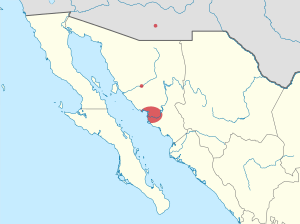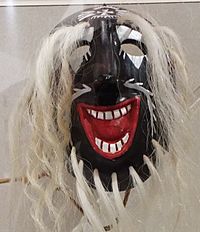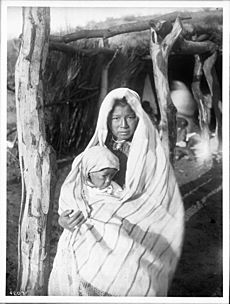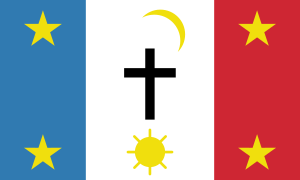Yaqui facts for kids
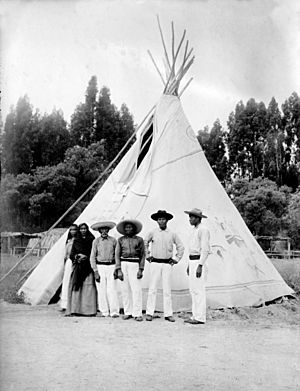
Yaqui People
|
|
| Total population | |
|---|---|
| c. 40 000 | |
| Regions with significant populations | |
| 16 240 (2019) | |
| 22 412 (2003) | |
| Languages | |
| Yaqui, English, Spanish | |
| Religion | |
| Indigenous Religion, Peyotism, Christianity, Roman Catholic | |
| Related ethnic groups | |
| Mayo Uto-Aztecan people | |
The Yaqui people, also known as Hiaki or Yoeme, are an Indigenous group from Mexico. They speak a language from the Uto-Aztecan family. Their homeland is in the valley of the Río Yaqui in the Mexican state of Sonora.
Many Yaqui also live in the Southwestern United States, especially in Arizona, California, and Nevada. The Pascua Yaqui Tribe in Tucson, Arizona, is the only Yaqui tribe officially recognized by the United States government.
Contents
Where Do Yaqui People Live?
In Mexico, many Yaqui live on special reserved lands in Sonora. Others have formed neighborhoods called colonias in cities. For example, in Hermosillo, areas like El Coloso and La Matanza are known as Yaqui districts. People there keep their Yaqui culture and language alive.
In the United States, a large Yaqui community called New Pascua (or Pascua Nuevo) was developed near Tucson, Arizona. About 4,000 people live there. Many middle-aged residents speak English, Spanish, and some Yaqui. Older people often speak Yaqui fluently, and more young people are learning it.
Another important Yaqui community is in Guadalupe, Arizona. Over 44% of its population are Native American, and many speak Yaqui, English, and Spanish. There's also a Yaqui neighborhood called Penjamo in South Scottsdale. More than 13,000 Yaqui are members of the Pascua Yaqui Tribe.
Yaqui Language and Names
The Yaqui language is part of the Uto-Aztecan language family. Yaqui is a Cahitan language, which means it's related to about 10 other languages once spoken in Sonora and Sinaloa. Today, only Yaqui and Mayo languages are still spoken.
Around 15,000 Yaqui speakers live in Mexico, and about 1,000 in the US, mostly in Arizona. The Yaqui call themselves Hiaki or Yoeme. Yoeme means "person" in their language, and yoemem means "people." Their homeland is called Hiakim.
Many Yaqui also call themselves Pascua Hiaki, meaning "The Easter People." This name came about because many Yaqui became Catholic due to Jesuit missionaries long ago.
Yaqui History: Protecting Their Land
Early Encounters with Europeans (1530s–1820s)
When the Spanish first met the Yaqui in 1533, the Yaqui lived along the lower Yaqui River. There were about 30,000 Yaqui people living in 80 villages. Some lived by the sea, while most farmed beans, maize, and squash near the river. Others hunted and gathered in the deserts and mountains.
In 1533, a Spanish leader named Captain Diego de Guzmán met the Yaqui. Their leader drew a line in the dirt and told the Spanish not to cross it. A battle happened, and the Spanish left. This started 40 years of fighting as the Yaqui protected their culture and land.
In 1617, the Yaqui invited Jesuit missionaries to live with them. For 120 years, the Yaqui and Jesuits had a good relationship. Most Yaqui became Christian but kept many of their old beliefs. The Jesuits introduced new crops like wheat and animals like cattle and horses. The Yaqui kept their land and stayed united.
However, by the 1730s, Spanish settlers started moving onto Yaqui land. This led to a revolt in 1740, where many people died. The Jesuits were later forced to leave Mexico in 1767. The Yaqui continued to keep much of their independence from Spanish rule.
Yaqui Wars and Forced Labor (1820s–1920s)
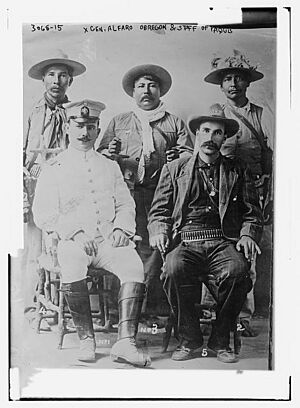
After Mexico became independent from Spain in 1821, the Yaqui refused to pay taxes to the new government. A Yaqui revolt in 1825 was led by Juan Banderas. He wanted to unite different Indigenous groups to form a state independent from Mexico. Though the Yaqui and their allies won some battles, Banderas was defeated and executed in 1833.
The Yaqui continued to fight against the Mexican government's efforts to control their land. They even supported the French during a short period in the 1860s. Under the leadership of Jose Maria Leyva, known as Cajemé, the Yaqui fought until 1887, when Cajeme was captured and executed.
During this time, the Mexican government took Yaqui lands. Many Yaqui became warriors fighting a guerrilla war. The government also forced many Yaqui into labor. Thousands were sent to work on sugar cane and henequen farms far from their homes. Many died due to harsh conditions and lack of food.
Yaqui resistance continued. Many Yaqui moved to the United States, settling in places like Texas, New Mexico, Arizona, and California. They often sent money and weapons back to those still fighting in Mexico. The last major battle between the Mexican Army and the Yaqui was in 1927. The Mexican forces used heavy weapons and planes to defeat the Yaqui.
For almost 400 years, the Yaqui's main goal was to have their own local government and control their own lands.
New Beginnings (1920s–1930s)
In 1937, Mexican President Lázaro Cárdenas set aside 500,000 hectares of ancestral Yaqui land. He also ordered a dam to be built for irrigation and provided modern farming tools. This helped the Yaqui maintain some independence from Mexican rule.
Thanks to these changes, the Yaqui produced much more wheat, maize, and beans by 1939. Today, a Mexican municipality called Cajemé is named after the brave Yaqui leader.
Yaqui Daily Life
In the past, the Yaqui were farmers, growing beans, corn, and squash. Those living near the Río Yaqui and coastal areas also fished. They were also skilled warriors. Historically, Yaqui people were described as quite tall.
A traditional Yaqui house had three parts: a bedroom, a kitchen, and a living room called the "portal." The floors were made of wood, walls of woven reeds, and roofs of reeds covered with mud for insulation. Many Yaqui homes have a wooden cross outside, especially important during Waresma (Lent).
Yaqui Beliefs and Traditions
The Yaqui have a unique way of seeing the world, different from their neighbors. They believe the universe has many overlapping worlds or places called aniam. There are at least nine different aniam, such as the flower world (sea ania), the enchanted world (yo ania), and the wilderness world (huya ania).
Yaqui rituals often focus on making these worlds perfect and healing any harm done to them. Many Yaqui combine these ideas with Catholicism. They believe that the world continues to exist because they perform their yearly Lent and Easter rituals.
Yaqui religion blends old Yaqui beliefs with Christian teachings from Jesuit missionaries. It involves songs, music, prayers, and dancing. For example, the Yaqui deer song (maso bwikam) goes with the deer dance. This dance is performed by a pascola dancer, also known as a "deer dancer." Pascolas perform at many events, especially during Lent and Easter.
Flowers are very important in Yaqui culture. Yaqui teachings say that flowers grew from the blood shed during the Crucifixion. Flowers are seen as a sign of souls. Sometimes, Yaqui men might greet a close male friend by saying Haisa sewa? which means "How is the flower?"
Yaqui Communities in the United States
Because of the wars in Mexico, many Yaqui moved to the United States. They settled in neighborhoods in cities like Tucson and Phoenix, Arizona. They built homes from available materials and worked as farm laborers. They worked hard to continue their important Easter and Lenten ceremonies.
In the 1960s, Yaqui spiritual leader Anselmo Valencia Tori asked for help for the Yaqui people. With support from others, the Pascua Yaqui Association was formed. In 1964, the U.S. government gave the Yaqui 817,000 square meters of land southwest of Tucson, Arizona.
To help the community grow, leaders like Valencia and Raymond Ybarra worked to get official federal recognition for the Yaqui people.
In 1978, a law was passed that officially recognized the Pascua Yaqui Tribe. This gave their lands reservation status and created a special relationship between the U.S. government and the Tribe. In 2008, the Pascua Yaqui Tribe had 11,324 voting members.
There is also a group in Texas called the Texas Band of Yaqui Indians. They identify as Mountain Yaqui descendants but are not officially recognized by the federal or state government.
Famous Yaqui People
- Loretta Lucero Alvarez (1892–1996), a Pascua Yaqui midwife in Tucson, Arizona.
- Mario Martinez, a painter from the Pascua Yaqui Tribe living in New York.
- Marcos A. Moreno, a public health advocate and scholar. He was the first person from the Pascua Yaqui Reservation to graduate from an Ivy League University.
- Marty Perez, a baseball player in the 1960s and 1970s. His Yaqui ancestors were from Sonora, Mexico.
- Anselmo Valencia Tori, a spiritual leader and tribal elder. He led the fight for the Pascua Yaqui Tribe to gain federal recognition in 1978.
|
See also
 In Spanish: Pueblo yaqui para niños
In Spanish: Pueblo yaqui para niños


